1. General Discussion
1.1 Background
1.1.1 History
Air samples were
received at SLTC collected on OVS-Tenax tubes requesting analysis for
dihexyl phthalate. OVS-Tenax tubes contain a glass fiber filter in
front of two resin beds of Tenax. Both the mixed isomers of dihexyl
phthalate (DHP) and di-n-hexyl phthalate (DNHP) were studied because
it was unknown which compound was collected on the samples. The DHP
contained di-n-hexyl phthalate, along with straight and branched chain
isomers of dihexyl phthalate. The analytical procedure chosen follows
OSHA 104, with toluene extraction and analysis by GC-FID.1
Toluene was found to give an extraction efficiency of 100% for DHP and
DNHP from the glass fiber filter and Tenax. DHP and DNHP were found to
be well retained on the glass fiber filter of the OVS-Tenax, with a
retention efficiency recovery of 99.8% for DHP and 99.7% for DNHP,
when 240-L of humid air was pulled through them. This indicates that
these compounds could be sampled with a glass fiber filter if they
were the only phthalate ester being sampled. OSHA method 104 indicates
that the lighter phthalate esters, such as dimethyl phthalate, need
the resin bed for collection, so the OVS- Tenax tube would be needed
to sample for dimethyl phthalate with DHP or DNHP.2
The storage stability recovery on Day 14 were 99.7% for DHP and 99.8%
for DNHP with ambient storage.
1.1.2 Toxic effects (This
section is for information only and should not be taken as the basis
of OSHA policy.)
Dihexyl phthalate is a contact irritant
affecting the skin and mucous membranes.3
In studies on mice, di-n-hexyl phthalate was a reproductive toxicant,
stopping reproduction at concentrations in feed of 1.67 g/kg/day,
greatly reducing reproduction at 0.8 g/kg/day, and at 0.38 g/kg/day
the litter size was deceased. In the high dose male mice group, the
testis weight was decreased by 70%, the epididymal sperm concentration
was reduced by 93%, and motility was reduced by 80% as compared to the
control group. DHNP was also found to affect the liver and
kidney.4
1.1.3
Workplace exposure5,6
DHP and DNHP are used in the
manufacture of plasticizers and resins. They are components of molding
and coating plastisols. They are used in the production of vinyl
flooring. Production exceeds one million pounds annually.
1.1.4
Physical properties and other descriptive information
| DHP7 |
|
|
|
| CAS number: |
68515-50-4 |
density: |
1.01 |
| molecular weight: |
344.50 |
IMIS:8 |
D940 |
| melting point: |
-27ºC |
boiling point: |
350ºC |
| appearance: |
clear liquid |
molecular formula: |
C20H30O4 |
| odor: |
aromatic |
flash point: |
192ºC (379ºF)(cc) |
| autoignition temperature: |
>500ºC |
|
|
| synonyms: |
1,2-benzenedicarboxylic acid, mixed
hexyl esters; Jayflex DHP; phthalic acid, mixed dihexyl
esters |
| solubility: |
acetone, alcohol, benzene, carbon
disulfide, carbon tetrachloride, and toluene |
| structural formula: |
where R1 = any C6 isomer,
and R2 = any C6 isomer |
| DNHP9 |
|
|
|
| CAS number: |
84-75-3 |
density: |
1.01 |
| molecluar weight: |
334.50 |
IMIS:10 |
D700 |
| melting point: |
-58ºC |
boiling point: |
345ºC |
| appearance: |
clear,liquid |
molecular formula: |
C20H30O4 |
| odor: |
aromatic |
flash point: |
192ºC (379ºF)(cc) |
| autoignition temperature: |
>500ºC |
|
|
| synonyms: |
1,2-benzenedicarboxylic
acid, n-hexyl ester; phthalic acid, dihexyl ester |
| solubility: |
acetone, alcohol,
benzene, carbon disulfide, carbon tetrachloride, and
toluene |
| structural formula: |
where R1 =
n-hexyl |
This method was evaluated according to the OSHA SLTC
"Evaluation Guidelines for Air Sampling Methods Utilizing Chromatographic
Analysis"". The Guidelines define analytical parameters, specify required
laboratory tests, statistical calculations and acceptance criteria. The
analyte air concentrations throughout this method are based on the
recommended sampling and analytical parameters.
1.2 Detection limit of the overall
procedure (DLOP) and reliable quantitation limit (RQL)
The DLOP
is measured as mass per sample and expressed as equivalent air
concentrations, based on the recommended sampling parameters. Ten
samplers were spiked with equal descending increments of analyte, such
that the highest sampler loading was 200 µg of DHP, and ten more were
spiked with DNHP with a highest loading of 36 µg. This is the amount
spiked on a sampler that would produce a peak approximately 10 times the
response for a sample blank. These spiked samplers were analyzed with
the recommended analytical parameters, and the data obtained used to
calculate the required parameters (standard error of estimate and slope)
for the calculation of the DLOP. The DLOP from the plots were 15.4 µg
DHP and 1.97 µg DNHP. The RQL is considered the lower limit for precise
quantitative measurements. It is determined from the regression line
parameters obtained for the calculation of the DLOP, providing 75% to
125% of the analyte is recovered. The RQL for the plots were 51.2 µg DHP
and 6.56 µg DNHP.
Table 1.2.1
Detection
Limit of the Overall Procedure for DHP
|
mass per
sample
(µg) |
area
counts
(µV-s) |
|
| 0.00 |
0 |
| 20.2 |
1657 |
| 40.4 |
2897 |
| 60.6 |
3969 |
| 80.8 |
5054 |
| 101 |
6273 |
| 121 |
7451 |
| 141 |
8970 |
| 162 |
9394 |
| 182 |
10231 |
| 202 |
11192 |
| |
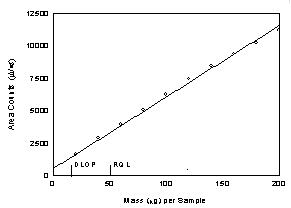
Figure
1.2.1. Plot of data to determine the DLOP/RQL for DHP, DLOP=15.4
µg and RQL=51.2 µg. (y=55.1X = 547) |
Table 1.2.2
Detection Limit
of the Overall Procedure for DNHP
|
mass per
sample
(µg) |
area
counts
(µV-s) |
|
| 0.00 |
0 |
| 4.04 |
284 |
| 8.08 |
478 |
| 12.1 |
679 |
| 16.2 |
956 |
| 20.2 |
1301 |
| 24.2 |
1536 |
| 28.3 |
1854 |
| 32.3 |
2039 |
| 36.4 |
2302 |
| |
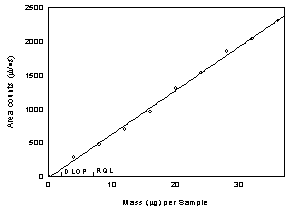
Figure
1.2.2 Plot of data to determine the DLOP/RQL for DNHP, DLOP = 1.97
µg and RQL = 6.56 µg. (Y=64.8X - 20.7) |
Below are chromatograms of the
RQL level.
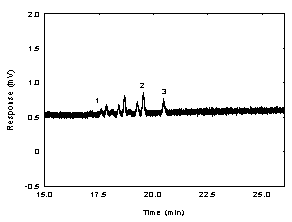
Figure
1.2.3. Chromatogram of the RQL of DHP. (1 through 2 = mixed
isomers of dihexyl phthalate; 3 = di-n-hexyl
phthalate)
|
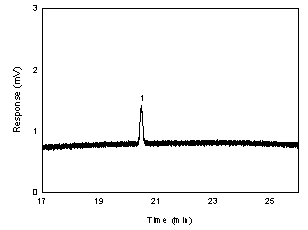
Figure
1.2.4. Chromatogram of the RQL of DNHP (1 =
DNHP). | 2.
Sampling Procedure
All safety practices that apply to the work area
being sampled should be followed. The sampling equipment should be
attached to the worker in such a manner that it will not interfere with
work performance or safety.
2.1 Apparatus
2.1.1 Samples are collected using a
personal sampling pump calibrated, with the sampling device attached,
to within ±5% of the recommended flow rate.
2.1.2 Samples are
collected with OVS-Tenax tubes. The tube contains a glass fiber filter
and two sections of Tenax separated by a urethane foam plug. For this
evaluation, commercially prepared sampling tubes were purchased from
SKC, Inc. (catalog no. 226-56).
2.2
Reagents
None required 2.3 Technique
2.3.1 Immediately before sampling,
remove the end caps from the OVS-Tenax tube. Use tube holders to
minimize the hazard of broken glass. All tubes should be from the same
lot.
2.3.2 The smaller section of the adsorbent tube is used as
a back-up and is positioned nearest the sampling pump. Attach the tube
holder to the sampling pump so that the adsorbent tube is in an
approximately vertical position with the inlet facing down during
sampling. Position the sampling pump, tube holder and tubing so they
do not impede work performance or safety.
2.3.3 Draw the air to
be sampled directly into the inlet of the tube holder. The air being
sampled is not to be passed through any hose or tubing before entering
the sampling tube.
2.3.4 After sampling for the appropriate
time, remove the adsorbent tube and seal it with plastic end caps.
Seal each sample end-to-end with an OSHA-21 form as soon as
possible.
2.3.5 Submit at least one blank sample with each set
of samples. Handle the blank sampler in the same manner as the other
samples except draw no air through it.
2.3.6 Record sample air
volumes (liters), sampling time (minutes) and sampling rate (mL/min)
for each sample, along with any potential interferences on the
OSHA-91A form.
2.3.7 Submit the samples to the laboratory for
analysis as soon as possible after sampling. If delay is unavoidable,
store the samples at refrigerator temperature. Ship any bulk samples
separate from the air samples. 2.4 Extraction efficiency
The extraction efficiency was
determined by liquid-spiking the glass fiber filter and the front
section of the Tenax separately with DHP and DNHP at 0.1 to 2 times
the target concentration. These samples were stored overnight at
ambient temperature and then extracted with toluene for 30 minutes
with occasional shaking, and analyzed. The mean extraction efficiency
over the studied range for DHP was 100% for the glass fiber filters
and 100% for the Tenax. The mean extraction efficiencyover the studied
range for DNHP was 100% for the glass fiber filters and 100% for the
Tenax. The wet extraction efficiency was determined at 1 times the
target concentration by liquid spiking the analyte onto either the
glass fiber filter or Tenax of OVS-Tenax tubes which had 240-L humid
air (absolute humidity of 15.9 mg/L of water, about 80% relative
humidity at 23ºC) drawn through them immediately before spiking. The
mean recovery for DHP from the wet samples was 99.9% on the glass
fiber filters and 100% on the Tenax. The mean recovery for DNHP from
the wet samples was 100% on the glass fiber filters and 100.2% on the
Tenax.
Table 2.4.1
Extraction Efficiency
(%) of DHP from Glass Fiber Filters
|
| level |
|
sample number |
|
| ×target |
mg per |
1 |
2 |
3 |
4 |
5 |
6 |
mean |
| concn |
sample |
|
|
|
|
|
|
|
|
| 0.1 |
0.12 |
98.7 |
98.8 |
100.4 |
99.4 |
101.1 |
100.1 |
99.8 |
| 0.25 |
0.30 |
99.9 |
100.4 |
100.8 |
99.7 |
100.4 |
100.3 |
100.3 |
| 0.5 |
0.60 |
99.3 |
100.7 |
101.8 |
98.6 |
100.1 |
101.0 |
100.3 |
| 1.0 |
1.2 |
99.3 |
98.0 |
99.9 |
98.5 |
102.2 |
101.1 |
99.8 |
| 1.5 |
1.8 |
100.0 |
100.4 |
99.5 |
99.3 |
99.9 |
100.1 |
99.9 |
| 2.0 |
2.4 |
99.2 |
101.2 |
100.5 |
97.2 |
99.6 |
99.3 |
99.6 |
|
|
|
|
|
|
|
|
|
| 1.0(wet) |
1.2 |
99.8 |
100.2 |
99.2 |
100.4 |
99.7 |
99.9 |
99.9 |
|
Table 2.4.2
Extraction Efficiency
(%) of DHP from Glass Fiber Filters
|
| level |
|
sample number |
|
| ×target |
mg per |
1 |
2 |
3 |
4 |
5 |
6 |
mean |
| concn |
sample |
|
|
|
|
|
|
|
|
| 0.1 |
0.12 |
99.6 |
101.3 |
100.4 |
100.0 |
100.2 |
99.6 |
100.1 |
| 0.25 |
0.30 |
99.1 |
100.2 |
100.5 |
99.4 |
99.9 |
100.3 |
99.9 |
| 0.5 |
0.60 |
100.4 |
98.9 |
99.8 |
100.2 |
100.0 |
100.9 |
100.2 |
| 1.0 |
1.2 |
99.7 |
100.1 |
99.0 |
99.9 |
100.4 |
99.6 |
99.8 |
| 1.5 |
1.8 |
100.8 |
99.7 |
100.9 |
99.7 |
99.9 |
100.5 |
100.3 |
| 2.0 |
2.4 |
99.0 |
100.9 |
99.7 |
99.2 |
98.5 |
101.2 |
99.8 |
|
|
|
|
|
|
|
|
|
| 1.0(wet) |
1.2 |
99.9 |
100.4 |
100.3 |
100.1 |
99.7 |
99.8 |
100 |
|
Table 2.4.3
Extraction Efficiency (%) of
DHP from Glass Fiber Filters
|
| level |
|
sample number |
|
| ×target |
mg
per |
1 |
2 |
3 |
4 |
5 |
6 |
mean |
| concn |
sample |
|
|
|
|
|
|
|
|
| 0.1 |
0.12 |
99.6 |
99.8 |
100.2 |
99.3 |
100.1 |
100.5 |
99.9 |
| 0.25 |
0.30 |
99.4 |
100.3 |
100.5 |
99.9 |
100.4 |
100.4 |
100.2 |
| 0.5 |
0.60 |
100.5 |
101.0 |
99.7 |
98.9 |
100.4 |
100.2 |
100.1 |
| 1.0 |
1.2 |
100.4 |
99.2 |
100.5 |
98.9 |
100.3 |
99.9 |
99.9 |
| 1.5 |
1.8 |
100.3 |
100.2 |
101.1 |
100.2 |
99.5 |
100.4 |
100.3 |
| 2.0 |
2.4 |
101.2 |
99.2 |
100.3 |
98.7 |
101.3 |
100.1 |
100.1 |
|
|
|
|
|
|
|
|
|
| 1.0(wet) |
1.2 |
100.3 |
99.4 |
99.7 |
100.8 |
99.4 |
100.3 |
100 |
|
Table 2.4.4
Extraction Efficiency (%) of
DHP from Glass Fiber Filters
|
| level |
|
sample number |
|
| ×target |
mg
per |
1 |
2 |
3 |
4 |
5 |
6 |
mean |
| concn |
sample |
|
|
|
|
|
|
|
|
| 0.1 |
0.12 |
99.9 |
99.4 |
101.0 |
100.3 |
100.5 |
99.1 |
100.0 |
| 0.25 |
0.30 |
100.1 |
100.0 |
100.4 |
99.2 |
100.2 |
99.0 |
99.8 |
| 0.5 |
0.60 |
100.8 |
100.3 |
99.5 |
98.6 |
101.0 |
100.7 |
100.2 |
| 1.0 |
1.2 |
99.9 |
101.2 |
98.7 |
100.8 |
99.7 |
100.5 |
100.1 |
| 1.5 |
1.8 |
100.6 |
99.3 |
99.1 |
99.9 |
99.3 |
100.8 |
99.8 |
| 2.0 |
2.4 |
100.2 |
99.6 |
100.6 |
98.9 |
100.1 |
99.4 |
99.8 |
|
|
|
|
|
|
|
|
|
| 1.0(wet) |
1.2 |
100.3 |
100.1 |
101.0 |
100.1 |
99.9 |
99.6 |
100.2 |
| 2.5 Retention
efficiency
On twelve OVS-Tenax tubes, the glass
fiber filter was moved from next to the Tenax resin to above the PTFE
retaining ring. Six OVS-Tenax tubes were spiked with 2.4 mg DHP and
the other six with 2.4 mg DNHP on the glass fiber filter and allowed
to equilibrate for 4 h. The tubes had 240 L humid air (absolute
humidity of 15.9 mg/L of water, about 80% relative humidity at 22.2°C)
pulled through them at 1 L/min. The samples were extracted and
analyzed. The mean recovery was 99.8% for DHP and 99.7% for DNHP.
There was no analyte found on the Tenax sections of any of the
tubes.
Table 2.5.1
Retention Efficiency (%)
of DHP
|
| sample number |
| section |
1 |
2 |
3 |
4 |
5 |
6 |
mean |
|
| glass fiber
filter |
98.8 |
100.6 |
99.7 |
99.8 |
100.2 |
99.7 |
99.8 |
| front Tenax
section |
0.0 |
0.0 |
0.0 |
0.0 |
0.0 |
0.0 |
0.0 |
| back Tenax
section |
0.0 |
0.0 |
0.0 |
0.0 |
0.0 |
0.0 |
0.0 |
| total |
98.8 |
100.6 |
99.8 |
99.8 |
101.2 |
99.7 |
99.8 |
|
Table 2.5.2
Retention Efficiency (%)
of DNHP
|
| sample number |
| section |
1 |
2 |
3 |
4 |
5 |
6 |
mean |
|
| glass fiber filter |
100.4 |
100.1 |
99.4 |
100.2 |
98.9 |
99.1 |
99.7 |
| front Tenax section |
0.0 |
0.0 |
0.0 |
0.0 |
0.0 |
0.0 |
0.0 |
| back Tenax section |
0.0 |
0.0 |
0.0 |
0.0 |
0.0 |
0.0 |
0.0 |
| total |
98.8 |
100.1 |
99.4 |
100.2 |
98.9 |
99.1 |
99.7 |
| 2.6 Sample
storage
Fifteen OVS-Tenax tubes were each
spiked with 1.2 mg DHP and the same number with 1.2 mg DNHP. They were
allowed to equilibrate for 4 h, then 240 L of air, with an absolute
humidity of 15.7 milligrams of water per liter of air (about 80%
relative humidity at 22.2ºC), was drawn through them. Three samples of
each compound were analyzed immediately. The remaining samples were
sealed, six of each compound were stored at room temperature (23ºC),
and the other six were stored at refrigerated temperature (4ºC). Three
samples from each forms of storage were analyzed after 7 days of
storage and the remaining three after 14 days of storage. The amounts
recovered, which are corrected for extraction efficiency, indicate
good storage stability for the time period studied.
Table 2.6.1
Storage Test for
DHP
|
|
ambient |
|
refrigerated |
|
| time (days) |
1 |
2 |
3 |
mean |
1 |
2 |
3 |
mean |
|
| 0 |
100.9 |
97.9 |
100.2 |
99.7 |
100.2 |
99.0 |
99.1 |
99.7 |
| 7 |
98.6 |
99.6 |
100.1 |
99.4 |
99.6 |
100.4 |
100.1 |
99.8 |
| 14 |
99.8 |
100.2 |
99.2 |
99.7 |
99.9 |
100.8 |
100.0 |
99.7 |
|
Table 2.6.2
Storage Test for DHP
|
|
ambient |
|
refrigerated |
|
| time (days) |
1 |
2 |
3 |
mean |
1 |
2 |
3 |
mean |
|
| 0 |
100.3 |
99.1 |
101.2 |
100.2 |
100.2 |
99.8 |
99.1 |
99.7 |
| 7 |
99.8 |
99.4 |
100.2 |
99.8 |
99.9 |
99.5 |
100.1 |
99.8 |
| 14 |
99.6 |
99.5 |
100.3 |
99.8 |
99.3 |
99.8 |
100.0 |
99.7 |
| 2.7
Recommended air volume and sampling rate.
Based on the data
collected in this evaluation, 240-L air samples should be collected at a
sampling rate of 1.0 L/min for 240 minutes
2.8
Interferences (sampling)
2.8.1 There are no known compounds
which will severely interfere with the collection of DHP and DNHP. The
following phthalates do not interfere under the analytical conditions
used in this method: dimethyl phthalate, diethyl phthalate, dibutyl
phthalate, di-sec-octyl phthalate, and di-n-octyl phthalate. Other
interfering compounds may be eliminated by changing analytical
conditions and/or column.
2.8.2 Suspected interferences should
be reported to the laboratory with submitted samples.
3. Analytical
Procedure
Adhere to the rules set down in your Chemical Hygiene
Plan. Avoid skin contact and inhalation of all chemicals and review all
appropriate MSDSs before starting analytical procedure.
3.1 Apparatus
3.1.1 A gas chromatograph equipped
with an FID. For this evaluation, a Hewlett-Packard 5890A Series 11
Gas Chromatograph equipped with a 7673A Automatic Sampler was
used.
3.1.2 A GC column capable of separating DHP and DNHP from
the desorption solvent, internal standard and any potential
interferences. A 60-m × 0.32-mm i.d. capillary DB-5 with a 1.5-µm df
(J&W Scientific, Folsom, CA) was used in the
evaluation.
3.1.3 An electronic integrator or some other
suitable means of measuring peak areas. A Waters
Millennium32 Data System was used in this
evaluation.
3.1.4 Glass vials with poly
(tetrafluoroethylene)-lined caps. For this evaluation 2-mL vials were
used.
3.1.5 A dispenser capable of delivering 4.0 mL of
desorbing solvent to prepare standards and samples. If a dispenser is
not available, a 4.0-mL volumetric pipet may be used.
3.1.7
Volumetric flasks - 10-mL and other convenient sizes for preparing
standards.
3.1.8 Calibrated 10-µL syringe for preparing
standards. 3.2 Reagents
3.2.1 Dihexyl phthalate (mixed
isomers). Exxon Mobile Chemicals 99% (lot CCNDD2) was used in this
evaluation.
3.2.2 Di-n-hexyl phthalate. ChemService 98% (lot
254-58B) was used in this evaluation.
3.2.2 Toluene, HPLC
grade. Fisher 99.8% (lot 924028) was used for this
evaluation.
3.2.3 n-Hexylbenzene, Reagent grade. Aldrich 99%
(lot 11703TR) was used in this evaluation.
3.2.4 The extraction
solvent was 0.25 µL/ml- n-hexylbenzene in toluene.
3.2.5 GC
grade nitrogen, air, and hydrogen. 3.3 Standard preparation
3.3.1 Prepare working analytical
standards by injecting microliter amounts of DHP and DNHP into
volumetric flasks containing the extraction solvent. An analytical
standard at a concentration of 0.303 mg/mL (0.3 µL/mL) is equivalent
to 5.05 mg/m³ based on a 240-liter air volume.
3.3.2 Bracket
sample concentrations with working standard concentrations. If sample
concentrations are higher than the concentration range of prepared
standards, either analyze higher standards, or dilute the sample. The
higher standards should be at least as high in concentration as the
highest sample. Diluted samples should be prepared with extracting
solvent to obtain a concentration within the existing standard range.
The range of standards used in this study was from .001 to 1.01
mg/mL. 3.4 Sample
preparation
3.4.1 Remove the plastic end caps from
the sample tubes and carefully transfer the glass fiber filter and
adsorbent sections to separate 4-mL vials. The glass fiber filter may
be place in the same vial with the front, larger, section of the
adsorbent. If other phthalates are being analyzed from the same tube,
such as dimethyl, diethyl, or dibutyl phthalate, the center urethane
foam plug should be included with the adsorbent section. Discard the
glass tube and back urethane foam plug.
3.4.2 Add 4.0 mL of
extraction solvent to each vial using the same dispenser as used for
preparation of standards.
3.4.3 Immediately seal the vials with
poly(tetrafluoroethylene)-lined caps.
3.4.4 Shake the vials
vigorously by shaker for 30 minutes.
3.4.5 Remove an aliquot of
each sample and place into labeled 2-mL vials, to fit into the
autosampler, for analysis. 3.5
Analysis
3.5.1 Gas chromatograph
conditions.
| GC
conditions |
|
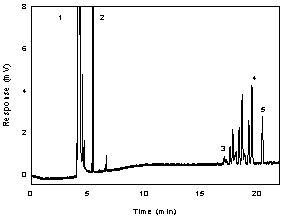
Figure 3.5.1 A
chromatogram of 303 ug/mL DHP in toluene with 0.25 uL/mL n-hexyl
benzene internal standard. Key: (1) toluene; (2) n-hexyl
benzene; (3) through (4) branched and linear isomers of dihexyl
phthalate; and (5) n-hexyl phthalate.
|
| zone
temperatures: |
220ºC (column),
hold 0 min, ramp at 10ºC/min to 260ºC, hold 22 min
250ºC
(injector)
250ºC (detector) |
| run time: |
26 min |
| column gas
flow: |
2.9 mL/min
(hydrogen) |
| septum
purge: |
1.9 mL/min
(hydrogen) |
| injection
size: |
1.0 µL (19:1 split) |
| column: |
60-m × 0.32-mm
i.d. capillary DB-5 (1.5-µm df) |
retention
times: |
4.17 min (toluene); 5.46 min (n-hexyl benzene);
17.05 min through 19.54 (isomers of DHP); 20.466 min
(DNHP) |
| FID
conditions |
|
|
| hydrogen flow: |
38 mL/min |
|
| air flow: |
450 mL/min |
|
makeup
flow:
(nitrogen) |
30 mL/min |
|
3.5.2 Peak
areas are measured by an integrator or other suitable
means.
3.5.3 An internal standard (ISTD) calibration method is
used. A calibration curve can be constructed by plotting
ISTD-corrected response of standard injections versus milligrams of
analyte per sample. Bracket the samples with freshly prepared
analytical standards over a range of concentrations.
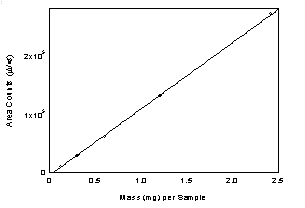
Figure
3.5.3.2. Calibration curve of DHP.
(Y = 1.13E5x -
4031) |
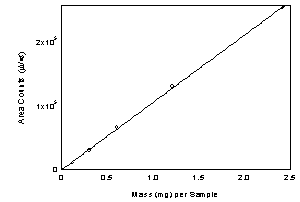
Figure
3.5.3.3. Calibration curve of DNHP.
(Y = 1.05E5x -
89.4) | 3.6
Interferences (analytical)
3.6.1 Any compound that produces a GC response and has a
similar retention time as the analyte is a potential interference. If
any potential interferences were reported, they should be considered
before samples are extracted. Generally, chromatographic conditions
can be altered to separate an interference from the
analyte.
3.6.2 When necessary, the identity or purity of an
analyte peak may be confirmed by mass spectrometry or by another
analytical procedure. The mass spectrum in Figure 3.6.2.1, 3.6.2.2,
and 3.6.2.3 were from the NIST spectral library. Mass spectra of other
isomers of dihexyl phthalate were not available.
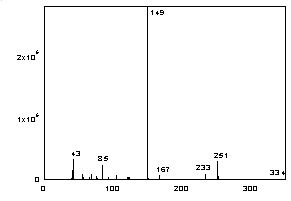
Figure
3.6.2.1. Mass spectra of di-n-hexyl phthalate. |
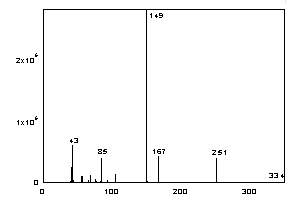
Figure
3.6.2.2. Mass spectra of di(2-ethylbutyl) phthalate. |
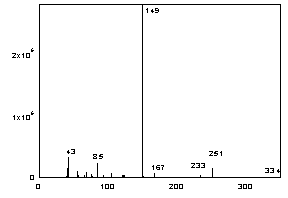
Figure
3.6.2.3. The mass spectrum of di(4-methylpentyl) phthalate. |
| 3.7 Calculations
The amount of analyte per sampler
is obtained from the appropriate calibration curve in terms of
micrograms per sample, uncorrected for extraction efficiency. This total
amount is then corrected by subtracting the total amount (if any) found
on the blank. The air concentration is calculated using the following
formulas.
 |
where: |
CM is concentration by weight
(mg/m³) |
|
M is micrograms per sample |
|
V is liters of air sampled |
|
EE is extraction efficiency, in
decimal form | 4.
Recommendations for Further Study
Collection, reproducibility, and
other detection limit studies need to be performed to make this a
validated method.
1 Chan, Y., OSHA 104, Dimethyl phthalate,
Diethyl phthalate, Dibutyl phthalate, Di-2-ethylhexyl phthalate, and
Di-n-octyl phthalate, 1994, http://www.osha-slc.gov/, (accessed
May 2001)
2 Chan, Y., OSHA
104, Dimethyl phthalate, Diethyi phthalate, Dibutyl phthalate,
Di-2-ethylhexyl phthalate, and Di-n- octyl phthalate, 1994, http://www.osha-slc.gov/, (accessed
May 2001)
3 Lewis, R., Sax's Dangerous Properties of Industrial Materials,
Van Nostrand Reinhold: New York, 2000, p 1310.
4 NIH, http://www.osha-slc.gov/pls/oshaweb/owaredirect.html?p_url=http%3A%2F%2Fntp-server.niehs.nih.gov%2Fhtdocs%2FRT-studies%2FRACB84093.html%20(accessed
5/10/01).
5 ExxonMobile
Chemical,
http://www.exxonchemical-products.com/chemical/customer/productst/fa.../index_content.html
(accessed 5/10/01).
6 Environmental Defense Fund.
http://www.scorecard.org/chemical-profiles/summary.tcl?edf_substance_id=68515-50-4
(accessed 5/10/01).
7 Material
Safety Data Sheet: Jayflex DHP, ExxonMobile Chemical Co., Atlanta, GA,
April. 2000.
8 OSHA Chemical
sampling Information.
http://www.osha.gov/dts/chemicalsampling/data/CH_273990.html (accessed
5/10/01).
9 Material Safety Data
Sheet: Di-n-hexyl phthalate, ChemService Chemical Co., West Chester,
PA, December, 1990.
10 OSHA
Chemical Sampling Information.
http://www.osha.gov/dts/chemicalsampling/data/CH_273990.html (accessed
5/10/01).
11 Burright, D.;
Chan, Y.; Eide, M.; Elskarnp, C.; Hendricks, W.; Rose, M. C. Evaluation Guidelines for Air Sampling Methods Utilizing
Chromatographic Analysis; OSHA Salt Lake Technical Center, U.S.
Department of Labor: Salt Lake City, UT, 1999.
|

